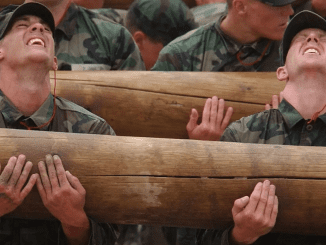
In 1970, along the outskirts of the Song Cau Lon River in Vietnam, a small, platoon-sized element of Navy SEALs had moments to spare. They’d expended all of their ammunition fighting off a North Vietnamese Army engagement minutes earlier and were sprinting toward the water for extraction.
The commandos, now down to only hand grenades, hoped to see backup waiting for them in the canal. The frogmen reached the water’s edge as a medium SEAL Support Craft flipped around like a speedboat to collect them before the boat laid down a wall of cover fire so they could climb aboard.
Kirby Horrell, a SEAL on the mission, told Coffee or Die what the extraction was like from his perspective. “Whit, [the driver], pivoted the boat — so now there was a minigun looking at those [NVA] guys,” he said. “That minigun goes Wooaaaaah, and we’re hanging on the boat anywhere we can to get the hell out of there.”
The gunboats of Vietnam that routinely rescued SEALs from certain death aren’t as well known as the commandos they protected. Today, the Special Warfare Combatant-Craft Crewmen, or SWCC (pronounced Swick), are often called the U.S. Navy’s “best kept secret.” Their legacy, though lesser known but no less important, dates back to the Beach Jumpers and PT Boats of World War II.
The WWII Units That Paved the Way for SWCC

A Motor Torpedo Boat, PT-105, underway. Wikimedia Commons photo.
The SWCC community has its roots in the heart of the Second World War. The units from that era that most resemble the SWCCs of today are the U.S. Navy’s Beach Jumpers and the Patrol Torpedo Boat Squadrons.
The Beach Jumpers were a psychological warfare unit that utilized agile boats to feign amphibious invasions on Axis-held beachheads. These missions created confusion and drew the enemy’s attention away from the intended Allied objective. The Beach Jumpers raided and assaulted beaches to create as much chaos as possible.
PT Boat Squadrons operated in the South Pacific, often for months on end without maintenance, fighting against various Japanese targets, including enemy planes, surface warfare ships, and enemy combatants on land. They also inserted commandos behind enemy lines and extracted pilots shot down over the ocean.
The most famous PT Boat operation of the entire war included future U.S. President John F. Kennedy Jr. During a nighttime patrol, his boat collided with a Japanese destroyer, and his team had to survive for a week on an island until they were rescued.
The Nasties of MACV-SOG/NAD

In early 1964, an elite special operations force took form. They were called MACV-SOG (Military Assistance Command, Vietnam — Studies and Observations Group). The top-secret unit primarily included Army Special Forces soldiers.
These Green Berets conducted reconnaissance and direct-action assaults into Vietnam, Cambodia, and Laos. However, the team also had a small detachment of Navy SEALs within their ranks. Some of these SEALs were from the Naval Advisory Detachment, essentially the maritime branch of MACV-SOG. The NAD used small boats to conduct harassment raids against North Vietnamese installations.
Lt. j.g. Jim Hawes, a SEAL formerly assigned to SEAL Team Two, was one of five officers who helped stand up MACV-SOG/NAD. His team took over OP PLAN 34-A, a CIA-run mission that conducted sabotage operations above the 17th parallel into North Vietnam. Hawes says that he had to start from scratch when he arrived in Bach Dang.
“The Navy had no small boats when we got there,” Hawes told Coffee or Die. “There were no manuals; there were no procedures; there were no nothing — so it was wonderful because we created it all.”
The CIA provided three 50-foot “Swifts” that could travel up to 50 knots. NAD also acquired disguised fishing boats called “junks.” But the best ships for maritime operations came later. These were the Norwegian “Nasty-Class” PT boats, or Nasties.

Hawes trained South Vietnamese boat crews and commandos for hit-and-run warfare. He said the Nasties, each equipped with 40mm guns and 81mm mortars, could outrun and outgun anything the North Vietnamese Army had at the time.
Hawes controlled night operations from afar, staging amphibious raids and mortar bombardments on NVA radar sites for several months. These targeted strikes were clandestine by nature and had a psychological impact in the early stages of the war.
On the night of Aug. 3, 1964, Hawes’ instructed the Nasties to target North Vietnamese radar installations and security bases at the islands of Hon Niu (or Hon Ngu) and Hon Mat (or Hon Me). The Nasties made their assault and destroyed their objectives, but on the way back to Da Nang, North Vietnamese watercraft trailed in pursuit. Hawes’ team outran them. However, the North Vietnamese were committed to retaliation.
According to Hawes, this NVA pursuit team allegedly carried out attacks against the USS Maddox and USS Turner Joy that exploded into the hugely controversial Gulf of Tonkin Incident, which many see as the official start of the Vietnam War.
As a response to the North Vietnamese vengeance, President Lyndon Johnson authorized an escalation of U.S. efforts in Southeast Asia.
Light SEAL Support Craft in Vietnam

In the 1950s, President Dwight D. Eisenhower had foreseen the need for a combined force to counter the growing insurgency issues plaguing our Allies worldwide. The British were engaged in Malaya, Kenya, and Yemen. The French were involved in operations in Indochina and Algeria.
Eisenhower feared the U.S. would soon enter a counterinsurgency campaign of its own. As a result, he directed the establishment of a direct predecessor of today’s Naval Special Warfare Group called the Naval Operations Support Group.
“The NOSG had the existing Beach Jumpers for amphibious deception, the Underwater Demolition Teams for hydrographic reconnaissance and obstacle demolition, the brand-new SEAL Teams for an unconventional special operations capability, and the new Boat Support Units,” said Phil Garn, a former SWCC veteran and current Combatant Craft Crewman Association historian.
In 1966, the SEALs began conducting direct-action raids in Vietnam. One squad of SEALs would crew the boats, while another squad would insert inland for missions.

Instead of dividing the force to keep up with mission demands, Phil Bucklew — a legend in the NSW community — advised standing up boat teams to insert and extract the SEALs. As a result, special boat teams filled this gap to adapt to the flexible mission of the SEALs.
“Boat Support Unit got four old World War II LCPLs [Landing Craft Personnel Large] and two heavy SEAL support craft,” Garn said. “These became Mobile Support Team 1 and Mobile Support Team 2.”
Missions to support the SEALs were fluid. A detachment from MST 1 would insert SEALs in one area, while another detachment from MST 1 would insert SEALs in a completely different place. Eventually, Adm. Elmo Zumwalt, the Chief of Naval Operations in Vietnam, wanted to test a new concept of deploying gunboats into any river or canal to control the waterways.
The Navy established a new unit called STABRON 20 [Strike Assault Boat Squadron Twenty] to fit the mission parameters.

The STABRON mission utilized a new tactic called maritime external air transport system, or MEATS, which used Light SEAL Support Craft or a Strike Assault Boat tethered by ropes to the bottom of CH-47 helicopters. The helicopters would airlift the boats into and out of hostile coastal zones
The Light Seal Support Craft relied on the SEALs for weaponry, but the STABs were equipped with M60 machine guns, grenade launchers, and an M2 Browning .50-caliber machine gun.
When the SEALs were in a jam, gunboats equipped with miniguns provided the Americans with an advantage. The miniguns quickly eliminated the enemy’s fire superiority in battle, if only for a short time. A wall of lead that could knock down trees and other vegetation allowed for the SEALs to extract despite being heavily outnumbered.
In the 1970s, NOSG became a Naval Special Warfare Group. The Boat Support Units also evolved and changed their name to become Coastal River Squadrons, then later the Special Boat Squadrons.
The monumental changes arrived in the 1980s when SBS entered U.S. Special Operations Command (SOCOM).
SOCOM to the GWOT

On April 16, 1987, the Naval Special Warfare Group entered SOCOM, bringing a new era for SWCC operators. Almost immediately, SWCC was tasked with its first mission, Operation Earnest Will.
In July 1988, detachments of various Special Boat Units, along with SEALs and the 160th Special Operations Aviation Regiment, deployed to the Persian Gulf. For several months, SBU teams operated from mobile sea bases converted from oil rigs to protect Kuwaiti tankers from Iranian attacks. These tasks mostly included day and night coastal patrol and interdiction missions using various watercraft.
In the 1990s, SWCC operated High-Speed Boats, or HSBs, RHIBs, and Mark V Special Operations Craft. In time, the so-called Dirty Boat Guys of SWCC carved out their own reputation, specifically during the Global War on Terror.
In the Philippines, SWCC used Mark Vs to rout Abu-Sayyaf extremists in the islands. The Mark Vs had five SWCCs manning M2 .50-caliber and M240 7.62mm belt-fed machine guns.

While these missions emphasized SWCCs firepower, some of the missions were more clandestine in nature, and the watercraft and weapons they chose for those missions reflected that.
“We were sending guys in dugout canoes with outboard motors for collection operations,” Garn said. “Two guys in a boat with pistols and a radio.”
SWCC also integrated with the SEALs and other special operations forces in unique ways. For example, Garn explained how SWCC joined SEAL platoons to work as drone operators.
“In Iraq, we were doing a lot more intelligence-gathering missions in the rivers,” Garn said. “We got into some hellacious gunfights, the biggest gunfights since the Vietnam War.”
The quiet professionals within the SWCC community have a long, respected history of always delivering on their “On Time, On Target” motto to mesh with American and Allied SOF units around the world.
What SWCC Does Today and How They Train

The primary role of SWCC is to maintain and operate highly advanced gunboats in support of special operations forces missions worldwide.
For example, off the coast of the horn of Africa, SWCC works in tandem with Navy SEALs during anti-piracy operations.
In 2009, Somali pirates hijacked the Maersk Alabama in the Indian Ocean and took the captain hostage — the incident that inspired the movie Captain Phillips. Eventually, the pirates piled into one of the ship’s small lifeboats and fled with Capt. Richard Phillips as a hostage.
While Navy SEAL snipers ultimately took out the pirates on the lifeboat with some amazing synchronized shooting from the fantail of the USS Bainbridge, if the pirates had remained on the merchant vessel, the Navy would have taken a different approach.
SWCC boats and operators would have parachuted into the Indian Ocean alongside the SEALs to conduct a Visit Board Search & Seizure, or VBSS, operation. This would require fast, agile boats to pull alongside the ship.
SEALs inside the SWCC boats would hook caving ladders on the hijacked vessel’s railings, climb aboard, and commence an assault. In order to pull off such a feat, SEALs and SWCC have to work together.

SWCC training is specialized and a bit unique. SEALs and SWCC have a similar pipeline but different selection courses. Unlike other special operations pipelines, officers and enlisted train together.
After time in the fleet or completing Navy recruit training, SEAL and SWCC candidates go to Coronado, California, where the bulk of their training is held.
SEALs and SWCCs both attend a five-week Naval Special Warfare Preparatory Course. Successful candidates move on to a two-week introduction to their own selection courses called Naval Special Warfare Orientation. Finally, those who meet the standard begin the first phase of instruction.
SEAL candidates move on to Basic Underwater Demolition/SEAL, or BUD/S, while SWCC candidates go to Basic Crewman Selection, or BCS.

Each course has three phases — BUD/S includes first, second, and third phases, while the SWCC BCS has alpha, bravo, and charlie phases. Each SWCC phase is approximately seven weeks long.
The alpha phase is a gut check consisting of physical training (running, swimming, and calisthenics), teamwork exercises, and classroom instruction. The culminating event — similar to the SEALs’ “Hell Week” — is called “The Tour,” which includes a multi-day exercise designed to simulate combat stressors, such as sleep deprivation, physical and mental exhaustion, and making critical thinking decisions under tight timelines.
The bravo phase teaches students maritime skills, navigation, and weapons handling, and the final charlie phase finally puts candidates inside the NSW Combatant-Craft, so they can get to know it through a series of training missions that include a joint exercise with SEAL candidates.
After additional specialized training, SWCC candidates are pinned with the Warboat insignia, formally recognizing them as new SWCC operators.
Teams, Crewmembers, Boats

In 2002, SWCC was reorganized under Naval Special Warfare Group 4, located in Little Creek, Virginia. Fewer than 1,000 SWCCs are assigned to three Special Boat Teams:
- Special Boat Team 12 in Coronado, California
- Special Boat Team 20 in Little Creek, Virginia
- Special Boat Team 22 in Stennis, Mississippi
Later in a SWCC’s career, more opportunities and special programs are available. This includes Naval Special Warfare Development Group, or SEAL Team 6. However, SWCCs have to attend their own selection course first to become eligible for integration into the Mobility Team within DEVGRU.
Each Special Boat Team also has their own arsenal of high-speed, well-armed boats to operate and maintain. The fleet is designed to fit a variety of mission parameters.

For example, Special Boat Team-12 (SBT-12) currently operates Combat Craft Assault (CCA) for VBSS operations, Combatant Craft-Medium (CCM) for insertion and extraction of SEALs, and Special Operations Personal Watercraft (PWC), aka jet skis. SBT-12 supports missions in the Pacific, Middle East, and wherever else they’re needed.
In contrast, SBT-20 operates CCAs, CCMs, Combatant Craft Heavy (also known as Sea Lions), and PWCs in support of missions primarily in Europe.
SBT-22 has CCAs as well as aluminum-hull, 33-foot-long Special Operations Craft-Riverine for missions along coastal or littoral environments worldwide. The SOC-R can travel up to 40 knots, carry a crew of four plus eight SEALs, and is equipped with weapon systems, including miniguns.
Despite the U.S. pulling out of major combat zones, the Global War on Terror continues to rage in hot spots all over the world. The work of SWCC will remain active, integrating with SEALs and Allied nations, without much fanfare. Their operations will remain close-guarded from the limelight, only to be covered by historians decades after their missions have transpired.


